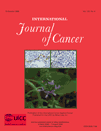Borderline ovarian tumors in Sweden 1960–2005: Trends in incidence and age at diagnosis compared to ovarian cancer
Abstract
The aim of the study was to investigate long-term trends in the incidence of borderline tumors and ovarian cancer in Sweden during 1960–2005, based on data from the population-based Swedish Cancer Register. We identified 6,288 patients with borderline ovarian tumors and a total of 34,977 cases of ovarian cancer during the study period. The age-standardized incidence of borderline ovarian tumors increased from 1.0 to 5.3 per 100,000 women-years from 1960–1964 to 2000–2005 and the incidence of ovarian cancer increased from 16.4 to 19.7 per 100,000 women-years from 1960–1964 to 1980–1989 and then declined to 16.6 per 100,000 women-years to the period 2000–2005. Borderline ovarian tumors comprised 15% of all primary ovarian neoplasms and the proportion increased from 8.3 to 23.6% during the study period. The median age at diagnosis for patients with borderline ovarian tumors and ovarian cancer was 55.2 and 61.6 years, respectively. In women younger than 40 years, 34% of all primary ovarian malignancies consisted of borderline ovarian tumors. For the 5 birth cohorts evaluated, the peaks of incidence occurred in stepwise younger age for each younger birth cohort for both borderline tumors and ovarian cancer. The increasing incidence of borderline ovarian tumors could be explained by an increase in diagnostic activity and by a lack of protective effect of oral contraceptive use. The decline in invasive tumors could be explained by a combination of factors, where the contribution of each is uncertain: shifting exposure to risk factors, a protective effect of oral contraceptive use, and increased detection of and removal of precancerous lesions. © 2008 Wiley-Liss, Inc.




